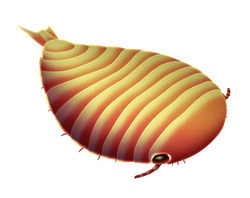Artiopoda
Artiopoda is a clade of extinct arthropods that includes trilobites and their close relatives. It was erected by Hou and Bergström in 1997 to encompass a wide diversity of arthropods that would traditionally have been assigned to the Trilobitomorpha. Trilobites, in part due to abundance of findings owing to their mineralized exoskeletons, are by far the best recorded, diverse, and long lived members of the clade. Other members, which lack mineralised exoskeletons, are known mostly from Cambrian deposits.
Description

According to Stein and Selden (2012) artiopods are recognised by the possession of filiform antennulae, limbs with bilobate exopods (upper branches), with the proximal (closest to base of the limb) lobe being elongate and bearing a lamella, while the distal (further from the limb base) lobe is paddle-shaped and setiforous (bearing hair-or bristle like structures). The limb endopod (inner, leg-like branch) has seven podomeres/segments, with first four podomeres bearing inward facing (endite) structures, while podomeres five and six are stenopodous (cylindrical and stout). Common plesiomorphies also include the antennules and at least three sets of post-antennular limbs being attached to the head shield, the postantennular limbs having no or little differentiation into distinct morphologies, and broad paratergal folds which contribute to the dorsoventrally (along the up-down axis) flattened look of artiopods. The limbs of artiopods have also been suggested to bear exites, which were described as similar those of the megacheiran Leanchoilia and probably not homologous to those present in crustaceans.
Taxonomy
Internal taxonomy
The Artiopoda have been considered by many studies to consist of two major clades; one reusing Trilobitomorpha to encompass trilobites, nektaspids, concilitergans and xandarellids, and the other called Vicissicaudata encompassing aglaspidids, xenopods and cheloniellids. There are some taxa, such as Squamacula and the members of "Protosutura", which often are placed near the base of Artiopoda, outside the Vicissicaudata+Trilobitomorpha clade. These relationships are not always recovered.
Relationships with other arthropods
The relationship of Artiopoda with the two major clades of modern arthropods, the Chelicerata and the Mandibulata, are unresolved, with some phylogenies recovering Artiopoda as more closely to chelicerates, forming the clade Arachnomorpha, while others recover Artiopoda as more closely related to mandibulates, forming the clade Antennulata. Some studies place them as stem-group euarthropods, with mandibulates and chelicerates more closely related to each other than either is to Artiopoda. Some studies have recovered a close relationship with Marrellomorpha, with the proposed clade including Artiopoda and Marrellomorpha dubbed Lamellipedia, though this relationship is not found in other analyses. The enigmatic artiopodan-like arthropod Kiisortoqia, which bears large "frontal appendages" has been suggested to be closely related to Artiopoda in some analyses.
Gallery
- Restoration of the trilobite Triarthrus eatoni
- Restoration of Naraoia magna (Nektaspida)
- Life restoration of Sidneyia (Vicissicaudata)
- Diagram of Sinoburius (Xandarellida)
- Life restoration of Aglaspis (Aglaspidida)
- Life restoration of Tegopelte (Conciliterga)
- Life restoration of Pleuroctenium (Agnostida)
Phylogeny
After Jiao et al. 2021.
| Artiopoda |
| |||||||||||||||||||||||||||||||||||||||||||||||||||||||||||||||||||||||||||||||||||||||||||||||||||||||||||||||||||||||||||||||||||||||||||||||||||||||||||||||||||||||||||||||||||||||||||||
Implied weights parsimony phylogeny after Berks et al. 2023.






















